Thoracic osteochondrosis is a serious pathology involving degenerative changes in the intervertebral discs.This disease is often caused by an inactive lifestyle, improper load distribution on the spine, and metabolic disorders of the intervertebral discs.
The disease has many symptoms but can easily be confused with manifestations of other pathological phenomena.Therefore, it is important to know how to recognize osteochondrosis of the thoracic spine.
Does your chest hurt?
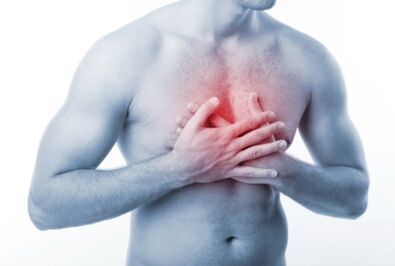
Chest pain is one of the common symptoms of thoracic osteochondrosis.Their occurrence is related to the following factors:
- Dysfunction of chest organs due to joint inflammation.
- Degenerative processes and atrophy at the junction of the spine and ribs.
- Increase the load on the spine.
- Inflammatory process in muscles.
One of the symptoms of osteochondrosis is chest tremors, causing pain..Although this area of the spine is considered the strongest from a physical point of view, it is easily affected by pathological processes.
refer to!Severe, sharp pain in the chest is called dorsago.It often occurs when a patient suddenly changes position after being in a stationary position for a long time.
The mechanism of the syndrome
The bone tissue of the spine gradually deforms under increased loading and other factors that trigger osteochondrosis.The disc slowly deteriorates and develops pathological growthCalled osteophytes.
These growths can cause blood vessels in the spinal cord to become pinched when the patient moves.Further development of the degenerative process leads to deterioration of blood circulation, including in the chest.Communication with the nervous system is disrupted.
As osteochondrosis progresses, pressure increases.Accordingly, the pain becomes more intense.Its location depends on the area where the degradation process occurs.
Signs of GOP pathology
The main symptoms of thoracic osteochondrosis (OS) are as follows:
- Chest pain, worsening at night;
- Pain between the shoulder blades, manifesting during bending of the arms and trunk;
- pain when breathing;
- Pain in the area under the ribs during exercise.
Let's think about what other symptoms there are, whether there is pain in the chest or stomach, where the pain is, whether the arms are affected in some way.
Additional symptoms are as follows:
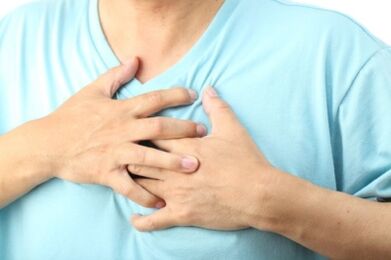
- chest pain.The main symptom of thoracic osteochondrosis is sternum pain.They may resemble heart pain, which can make diagnosis difficult.Pain may also occur in the lower back, sides, and abdominal cavity.
- Feeling of lump in chest.Also common.The feeling of a lump in the chest is related to compression of the nerve endings.When this happens, it is important not to panic as the symptoms are neurological in nature and the condition may worsen.
- Headache.Headaches are more common in cervical osteochondrosis, but they can also be felt in thoracic osteochondrosis.Its occurrence is associated with circulatory disorders.
- between shoulder blades.Sometimes the pain is only in the interscapular area.Usually in this case it has to do with breathing.
- combustion.There may also be a burning sensation in the chest.It is usually accompanied by compressive pain that radiates to the heart.Symptoms can be similar to a heart attack, which can be scary for the patient.
- My hands are going numb.Osteochondrosis may also cause numbness in the extremities.It is related to circulatory system problems.
- given to stomach area.If osteochondrosis affects the chest area, pain may radiate to the stomach area.Gastrointestinal disorders and the development or worsening of internal organ lesions are also possible.The pain is often caused by compression of the nerves that connect the back to the gastrointestinal tract and pelvis.
Discomfort can easily be confused with pain caused by digestive disorders.
- hernia pain.With osteochondrosis, the layer of cartilage located between the vertebrae is put under pressure, causing the cartilage to become deformed.As a result, the bone tissue grows and a hernia occurs.By reaching out, it stimulates nerve endings, causing pain in various parts of the body.
- Painful swallowing.If the disease is located in the upper sternal area, pain may occur in the pharynx or esophagus.There is a lump in the throat.Swallowing problems may also occur, especially when eating foods that are large or that irritate the lining of the esophagus.
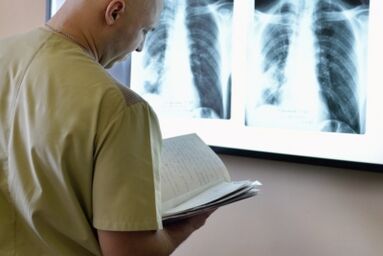
diagnosis
The following tests are used to diagnose osteochondrosis::
- Examination by orthopedic surgeons and surgeons;
- Chest X-ray;
- electrocardiogram;
- Abdominal and thoracic ultrasound;
- General urine and blood tests;
- Gastroduodenoscopy (use of a probe to examine the stomach and intestines).
These techniques can confirm that symptoms present are the result of osteochondrosis and not another disease.
What are sternal pain and sternal chondrosis often confused with?
Sternal pain due to osteochondrosis is most often confused with heart pain.They may also be confused with pain syndromes caused by digestive disorders.To determine the exact cause, doctors perform differential diagnosis.
How does it differ from cardiac pathology?
The pain caused by cervical osteochondrosis is similar to the pain caused by heart disease.It is difficult for patients to distinguish between them and requires an electrocardiogram to diagnose.If we are talking about heart diseases, then glyceryl trinitrate will easily relieve the pain, while in osteochondrosis it will not relieve the symptoms.
With VSD, there is an extra feel:
- Tachycardia and bradycardia;
- There is a feeling of fear;
- Persistent weakness and fatigue.
The pain is usually dull, whereas in osteochondrosis it is compressive.
How long do they last?
The pain may come in brief bursts and last for several minutes.If we are talking about a long-term pain syndrome, it may not go away for 2-3 weeks.Significant symptoms usually last up to 5 days.
Are symptoms different for men and women?

The main symptoms of thoracic osteochondrosis do not differ between men and women.
However,Diagnosing pathologies in women is more difficult due to hormonal characteristics.In young patients, it fluctuates constantly.During menopause, the synthesis of certain hormones decreases, which may trigger a number of pathologies requiring differential diagnosis.
In men, the disease has a typical course, so it can be quickly recognized and treatment started.
Treatment
Treatment for the disease itself and chest pain should be chosen by your doctor.Often, complex treatment is required.
drug
Drugs are currently the main method of treating osteochondrosis.Here are some possible treatments for chest lesions::
- NSAIDs help eliminate inflammation.
- Chondroprotectants are designed to restore the structure of damaged cartilage.
- Muscle relaxants provide relaxation and muscle tone.
- Preparations to normalize metabolic processes.
- Vitamin and mineral complex.
These medications may be prescribed as tablets or injections.If the pain is severe, therapeutic blockade can provide relief to the patient.
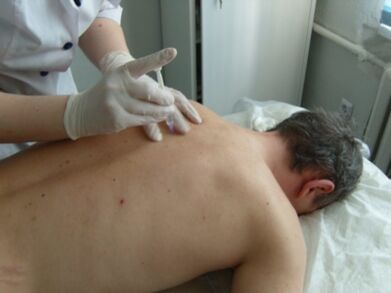
Intra-articular injection
In some cases, it is necessary to introduce chondroprotective agents directly into the affected joint.
Medication helps:
- Restores the elasticity of the intervertebral discs between vertebrae;
- Fill affected tissues with essential nutrients;
- Prevent them from further damage.
blockade
Therapeutic blockade aims to quickly relieve pain and inflammation, as well as allowing patients to return to normal activities.It can be articular and periarticular.In the latter case, the drug is not injected into the joint itself, but into the tissue near the joint.This method is gentler and equally effective, but the results appear slower.
gymnastics
Exercise helps strengthen muscles, normalizes the function of ligaments, muscles and joints, and reduces static tension in the spine.They should be chosen by a doctor.As a rule, gymnastics are performed only during the remission phase.
attention!The pain should not get worse during the exercise.
What exercises should I do if I have a hernia?
Your doctor may prescribe special exercises for hernias.It can be performed only when the pathological process has subsided.An important condition is the absence of severe pain syndrome.
For this condition, exercises with a stick are often recommended.Bends, turns, and other simple movements designed to work the chest area can be performed.
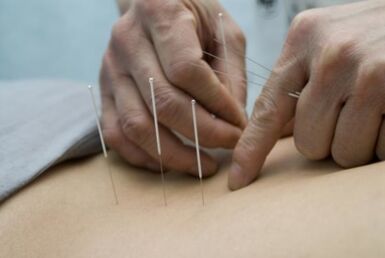
physical therapy
Chest osteochondrosis can be treated with physical therapy:
- vibration massage;
- UV irradiation;
- acupuncture;
- Mud therapy and light therapy.
These methods help relieve pain, speed tissue repair, and reduce inflammation.
massage
The main goal of therapeutic massage is to improve blood circulation, which has a beneficial effect on the treatment of diseases.
manual therapy
Manual therapy is performed only after a thorough examination of the patient.Acute pain is contraindicated.Its main task is to eliminate spinal deformation, restore blood circulation, and improve athletic ability.
No manual therapy:
- Have high blood pressure;
- After spinal injury;
- In the acute phase of a chronic pathology;
- Have vascular disease;
- infectious disease.
There are times when there are taboos:
- oncology;
- Central nervous system lesions;
- Increased intracranial pressure.
The therapeutic effect is to restore muscle function, improve blood circulation in the vertebral tissue and normalize metabolic processes.
hood
This method involves stretching muscles and ligaments, which makes it possible to widen the distance between vertebrae and eliminate nerve compression.As a result, the pain syndrome is significantly reduced.
folk remedies
Folk remedies cannot replace traditional medicine, but they can complement treatments.The most popular recipes include the following:
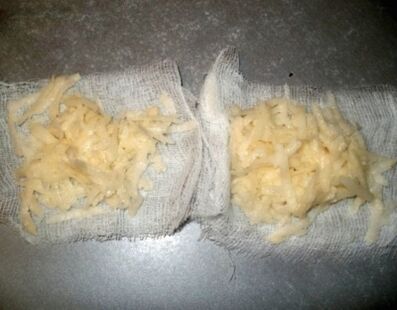
- A compress made from raw potatoes.You need to grate the potatoes, mix them with honey in equal proportions, mix well.Apply the composition to the affected area, set like a compress and leave it for two hours.Then you need to wash off the paste with warm water.
- This prescription can be used externally or internally.You need to prepare 50 grams of high-quality vodka, 150 grams of liquid honey, a radish and four teaspoons of salt.Grate the potatoes and mix with the rest of the ingredients.
The gruel can be applied to the affected area as a liniment.You can also use this product as a tincture.Consume twice a day, morning and evening, for a week.
- You can also rub 250 grams of sunflower oil and chopped fresh oregano to relieve pain caused by osteochondrosis in the chest.
How to mitigate attacks?
Medications are often used to stop attacks.In some cases, pharmacological blockade may be required.
Medication may be prescribed:
- anti-inflammatory drugs;
- Chondroprotectant;
- Muscle relaxants;
- nootropics;
- diuretics;
- B vitamins.
To normalize local blood circulation, a light massage can be performed.

prevention
It is easier to prevent any disease than to treat it.To reduce the likelihood of osteochondrosis developing or worsening,It’s important to monitor your lifestyle.
- While working a sedentary job, you need to take regular breaks and engage in physical activity.
- It is also important to give up bad habits, control your posture, get enough sleep and avoid stress.
How to eat right when you are sick?
Proper nutrition can help speed up the recovery process and prevent disease.The diet is based on:
- fish;
- Meat;
- dairy products;
- beans
It's also important that your diet includes fresh fruits and vegetables.Food should not be fried – it is best boiled, grilled or steamed.
It is important to limit consumption:
- Salt;
- spices;
- spices.
Still need to be careful:
- bacon;
- pickled dishes;
- candy.
If you are overweight, it is important to follow a diet designed to lose weight.You need to drink lots of water.But you shouldn't drink coffee - it flushes calcium from the body, which is harmful for osteochondrosis.It is also recommended to avoid alcohol.
Expert recommendation
In addition, experts also give the following suggestions:

- To prevent aggravation of the condition, be careful when exercising.It is important to avoid severe stress, fatigue and hypothermia.
- You need to pay attention to any other symptoms.This will help in timely diagnosis of the disease.These include headaches, dizziness, nausea and breathing problems.
- You should not prescribe medications yourself - the doctor should choose the drug based on the severity of the pathological process and existing symptoms.
- In case of acute pain, it is recommended to call an ambulance or consult a neurologist.
Analgesics and topical analgesics may be used to relieve pain.
- If the condition worsens, bed rest is necessary.The amount of activity should be kept to a minimum.
- If the pain is caused by a hernia, a special corset will be worn.In some cases, surgery is not possible.It is performed after detailed diagnosis and exclusion of other pathologies.
- It is important to adopt the correct posture while sleeping.It is recommended to sleep on your back and use a firm, dense mattress.When the vertebrae return to their normal physiological position, the discomfort disappears.
Osteochondrosis of the chest is not only an unpleasant disease, but also a dangerous one.Timely and comprehensive treatment is required.The doctor decides what treatment should be given.The patient must comply with all advice received from him and lead an appropriate lifestyle.
























